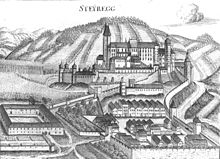Steyregg Castle
The Steyregg Castle is a private castle in Upper Austria and is located above the center of the city Steyregg in Mühlviertel . The castle was built under the Ottocars in the 11th or 12th century. The expansion to the castle took place under the Jörgern at the end of the 16th century. Today the castle is privately owned and can be rented for events.
history

The builder of Steyregg Castle is an Ottokar von Steyr from the Traungau family , who had the castle built in the 11th or 12th century. An exact date has not been reported. In 1147 the complex is mentioned as a Passau fief, the owner at that time, Hartwik von Hagenau , died that year. His successor was Provost Otto von Lengbach, before Leutold von Wildon became the owner in 1235 . In 1280 Ulrich II von Kapellen bought the castle. After 1406 it came into the possession of the Liechtensteiners through marriage . The Liechtensteiners enlarged the castle and the rule. The latter received high jurisdiction around 1535 .
In 1581 Wolfgang Jörger bought the castle. The Jörger converted it into a renaissance castle, built the castle chapel, set up an extensive library and acquired a collection of paintings. In 1594 the castle was one of the refuges during the Turkish threat. Since the Jörger were Protestants, their goods were taken from them during the Counter Reformation (1620). Helmhard Jörger got the castle back five years later. In 1638 the castle came into the possession of David II. Ungnad von Weissenwolff , Helmhard's son-in-law and later governor of the Enns . In 1679 Helmhart Christoph von Weissenwolff bought Castle Luftenberg and united the two lords. Under Josef Anton Graf Weissenwolff a family entailment commission for the two castles was set up. Around 1750 the rule had 622 subjects.
Lightning strikes caused fires in 1770 and 1779, which devastated the castle and the city. The destroyed parts of the building and the west tower were not rebuilt. After 1779 the former gardener's house was converted into a new castle. In 1917 the male Weissenwolff died out and the Thurn und Taxis family, who were related by marriage , inherited the castle. Irene Princess von Thurn und Taxis married former count Niklas Salm-Reifferscheidt in 1940 . During the Second World War , the castle was badly hit by aerial bombs and the baroque part of the new castle was destroyed. In the post-war period, Steyregg served as an emergency shelter for displaced persons. In 1956 a makeshift renovation of the castle followed.
In 1962 the castle became the property of the Salm-Reifferscheidt family and from 1966 it was completely empty. In the late 1980s, the castle was renovated. After the revitalization in 2004/2005, the knight's hall of the castle is available for events. Today the castle is the seat of the Salm-Reifferscheidt family and houses an important Japanese collection from the estate of the Japanese Foreign Minister Aoki Shūzō , who is one of the ancestors of today's castle owners.
building
The castle above Steyregg is the town's landmark. Due to fires and war damage, the castle was reduced to its present size. The current four-storey building is the former east wing and only a third of the former castle. The castle is surrounded by a park from the 19th century. Two fountains in the park bear the dates 1670 and 1727 and the coats of arms of the Weissenwolffs and Jörger.
The original access to the castle was from the city side. The castle was protected from the surrounding area by a moat. The large courtyard was created by removing the west tower after the fire in 1779. The facade is structured in the south and east by Tuscan pilasters . Today's main entrance was once the connection to the Meierhof .
Inside there is a 30 × 20 meter, two-story ballroom, which is considered the largest of its kind in Upper Austria. The castle chapel is also two-story and is dedicated to Saint John the Baptist. The chapel was redesigned in Baroque style in the 17th century, and in 1954, Gothic frescoes from the 14th century were exposed during the renovation.
See also
literature
- Oskar Hille: Castles and palaces of Upper Austria. 2nd edition, Wilhelm Ennsthaler, Steyr 1992, ISBN 3-85068-323-0 .
Web links
- Steyregg Castle
- Entry via Steyregg to Burgen-Austria
Coordinates: 48 ° 17 ′ 12 ″ N , 14 ° 22 ′ 19 ″ E


